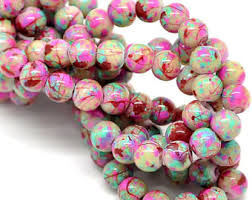Business Overview (Introduction)
 A major source of glass beads used in the fur trade was Venice, Italy. Venetians held a near monopoly on the bead industry for nearly 600 years. A guild of Venetian glass makers existed in 1224 A. D.. Around 1291, a large portion of the Venetian glass industry moved to Murano, an island north of Venice; city fathers feared an accident with one of the glass furnaces could destroy the city.
A major source of glass beads used in the fur trade was Venice, Italy. Venetians held a near monopoly on the bead industry for nearly 600 years. A guild of Venetian glass makers existed in 1224 A. D.. Around 1291, a large portion of the Venetian glass industry moved to Murano, an island north of Venice; city fathers feared an accident with one of the glass furnaces could destroy the city.
For over two hundred years, beads were made in Murano by a method known as "winding." With this method, beads were made individually by drawing a molten glob of glass out of the furnace and winding it around an iron rod. Glass of another color could then be added, or the bead could be decorated with a design. Coloring agents were added to the molten glass: cobalt made blue; copper produced green; tin made a milky white; and gold resulted in red. Wound beads from a master glassmaker were so perfect it was hard to find a seam where the different molten glasses merged.
Another method was blown glass beads. Using this method, a glob of molten glass was removed from the furnace and the desired shape obtained by blowing through a glass tube—much the same way glass vases are made.
The glass industry was able to keep up with demand using these two methods until the mid- to late 1400’s. Once European countries started sending ships around the world, ship captains and explorers carried beads made of glass, porcelain, and metal to use as gifts, or for the fur trade. The slow method of winding beads could not keep up with this new demand.
Around 1490, Venetians started to make beads from tubes of drawn glass; Egyptians may have used this process centuries before. With this procedure, a master glassmaker took a glob of molten glass from the furnace and formed a cylinder. After working the cylinder into the desired shape, he attached a rod to the cylinder. An assistant took the end of the rod and run down a long corridor before the glass cooled.
The drawn glass tube was about one hundred and twenty meters long. The length of the tube and the amount of glass used determined the size of the beads. Once the tubes cooled, they were cut into meter long pieces. These pieces were cut into beads of various sizes.
The cut beads were placed in a large metal drum containing lime, carbonate, sand, carbon, and water. While the metal drum turned, heat was applied to the outside causing the rough-cut edges to be smoothed. After the beads were smooth, they were cleaned and then placed in a sack of fermented bran and vigorously shaken to polish them. The monochrome glass beads of today are not much different from those made five hundred years ago.
By the 1500;s, the demand for glass beads reached the point Venetians were sending drawn glass tubes to Bohemia. There the glass tubes were broken into beads, polished, and sent back to Venice. The Bohemians (Czechoslovakia) had been making glassware, vases, and cups since the twelfth century.
With an abundance of willing workers, quartz for the silicon base of glass, and potash from wood-burning furnaces, Bohemia sent men to work in the glass factories of Murano. The knowledge these men brought back on how to make the drawn glass tubes turned Bohemia into a major producer of glass beads. By the mid-eighteen hundreds, Bohemia was producing more glass beads than the factories in Murano.
China was also a source of glass trade beads. Studies by Peter Francis, Jr., Director of the Center for Bead Research, has shown beads from China were brought to Mexico with the Spanish galleon trade. This trade route linked Chinese ports with Manila and Acapulco, and from there to the rest of the Spanish Empire in the Americas. Russians acquired Chinese beads from trading post on the Mongolian border and transported them to Alaska. A few Chinese glass beads have been found along with Venetian beads on Colonial Spanish 17th century sites…one of America's top archaeologist, David Hurst Thomas excavated over 62,000 beads from St. Catherine, the northern most Spanish mission on the Atlantic coast.